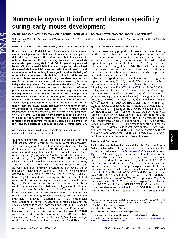摘要
Nonmuscle myosins (NMs) II-A and II-B are essential for embryonic mouse development, but their specific roles are not completely defined. Here we examine the isoforms and their domain specifically in vivo and in vitro by studying mice and cells in which nonmuscle myosin heavy chain (NMHC) II-A is genetically replaced by NMHC II-B or chimeric NMHC IIs that exchange the rod and head domains of NM II-A and II-B. In contrast with the failure of visceral endoderm formation resulting in embryonic day (E)6.5 lethality of A(-)/A(-) mice, replacement with NM II-B or chimeric NM IIs restores a normal visceral endoderm. This finding is consistent with NM II's role in cell adhesion and also confirms an essential, isoform-independent requirement for NM II in visceral endoderm function. The knock-in mice die between E9.5 and 12.5 because of defects in placenta formation associated with abnormal angiogenesis and cell migration, revealing a unique function for NM II-A in placenta development. In vitro results further support a requirement for NM II-A in directed cell migration and focal adhesion formation. These findings demonstrate an isoform-specific role for NM II-A during these processes, making replacement by another isoform, or chimeric NM II isoforms, less successful. The failure of these substitutions is not only related to the different kinetic properties of NM II-A and II-B, but also to their subcellular localization determined by the C-terminal domain. These results highlight the functions of the N-terminal motor and C-terminal rod domains of NM II and their different roles in cell-cell and cell-matrix adhesion.
- 出版日期2010-8-17
- 单位NIH
